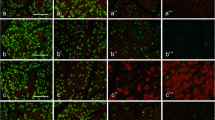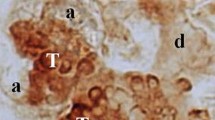Summary
The fine structure of the submandibular gland of the mouse with testicular feminization (Tfm/Y) was studied by light and electron microscopy. The architecture of the Tfm/Y gland proved to be rather similar to that of the normal female mouse in both tubular ratio and structure. Granular convoluted tubular cells in Tfm/Y mice characteristically had fewer secretory granules and increased cytoplasmic vacuoles than normal littermates, suggesting an altered synthesis of secretory granules in this cell type of the Tfm/Y mouse. Moreover, there were differences in the ultrastructure of submandibular glands between Tfm/Y and normal female mice. In the gland of the Tfm/Y mouse, basal striations of the striated secretory tubular cells were not so developed and granular intercalated duct cells were less than those of normal females. These findings support the evidence that the secretory tubule of the mouse submandibular gland responds to androgens, resulting in accentuated development in the male, while also suggesting the possibility that the mouse submandibular gland is regulated by other factors which lead to the prominent sexual dimorphism observed in this gland.
Similar content being viewed by others
References
Aloe L, Levi-Montalcini R (1980) Enhanced differentiation of sexually dimorphic organs in L-thyroxine treated Tfm mice. Cell Tissue Res 205:19–29
Andrew EJ, Bullock LP (1972) A morphological and histochemical evaluation of sexual dimorphism in androgen-insensitive pseudohermaphroiditic mice. Anat Rec 174:361–370
Bardin CW, Bullock LP (1972) Testicular feminization: Studies of the molecular basis of a genetic defect. J Invest Dermatol 63:75–84
Barka T (1980) Biologically active polypeptides in submandibular glands. J Histochem Cytochem 28:836–859
Barthe PL, Bullock LP, Mowszowicz I, Bardin CW, Orth DN (1974) Submaxillary gland epidermal growth factor: A sensitive index of biologic androgen activity. Endocrinology 95:1019–1025
Bing J, Poulsen K, Kackenthal E, Rix E, Taugner R (1980) Renin in the submaxillary gland: A review. J Histochem Cytochem 28:874–880
Caramia F (1966) Ultrastructure of mouse submandibular gland. I. Sexual differences. J Ultrastruct Res 16:505–523
Chrétien M (1977) Action of testosterone on the differentiation and secretory activity of a target organ: The submaxillary gland of the mouse. Int Rev Cytol 50:333–396
Goldstein JL, Wilson JD (1972) Studies on the pathogenesis of the pseudohermaphroditism in the mouse with testicular feminization. J Clin Invest 51:1647–1658
Gresik EW, MacRae EK (1975) The postnatal development of the sexually dimorphic duct system and of amylase activity in the submandibular glands of mice. Cell Tissue Res 157:411–422
Gresik EW, Chung KW, Barka T, Schenkein I (1980) Immunocytochemical localization of nerve growth factor, epidermal growth factor, renin and protease A in the submandibular glands of Tfm/Y mice. Am J Anat 158:247–250
Hosoi K, Kobayashi S, Ueha T, Maruyama S, Sato S, Takuma T, Kumegawa M (1979) Induction of androgen-dependent protease and serous-like granules by tri-iodothyronine in the submandibular gland of mice with testicular feminization. J Endocrinol 83:429–434
Junqueira LC, Fajer A, Rabinovitch M, Frankenthal L (1949) Biochemical and histochemical observations on the sexual dimorphism of mice submaxillary glands. J Cell Comp Physiol 34:129–158
Lacassagne A (1940) Dimorphisme sexuel de la glande sous-maxillaire chez la souris. CR Soc Biol (Paris) 133:180–181
Lyon MF, Hawkes SG (1970) X-linked gene for testicular feminization in the mouse. Nature 227:1217–1219
Lyon MF, Hendry I, Short RV (1973) The submaxillary salivary glands as test organs for response to androgen in mice with testicular feminization. J Endocrinol 58:357–362
Murphy RA, Watson AY, Metz J, Forssmann G (1980) The mouse submandibular gland: An exocrine organ for growth factors. J Histochem Cytochem 28:890–902
Ohno S, Lyon MF (1970) X-linked testicular feminization in the mouse as a noninducible regulatory mutation of the Jacob-Mond type. Clin Genet 1:121–127
Raynaud J (1960) Control hormonal de la glande sous-maxillaire de la souris. Bull Biol Fr Belg 94:339–523
Schenkein I, Levy M, Bueker ED, Wilson JD (1974) Immunological and enzymatic evidence for the absence of an esteroproteolytic enzyme (protease D) in the submandibular gland of the Tfm mouse. Endocrinology 94:840–844
Verhoevn G, Wilson JD (1976) Cytosol binding in submandibular gland and kidney of the normal mouse and the mouse with testicular feminization. Endocrinology 99:79–92
Author information
Authors and Affiliations
Rights and permissions
About this article
Cite this article
Matsuura, S., Sahara, N. & Suzuki, K. Fine structure of submandibular glands of mice with testicular feminization (Tfm/Y). Cell Tissue Res. 235, 295–301 (1984). https://doi.org/10.1007/BF00217853
Accepted:
Issue Date:
DOI: https://doi.org/10.1007/BF00217853




